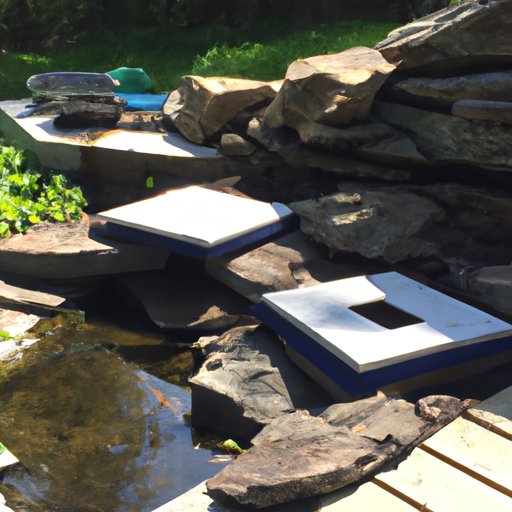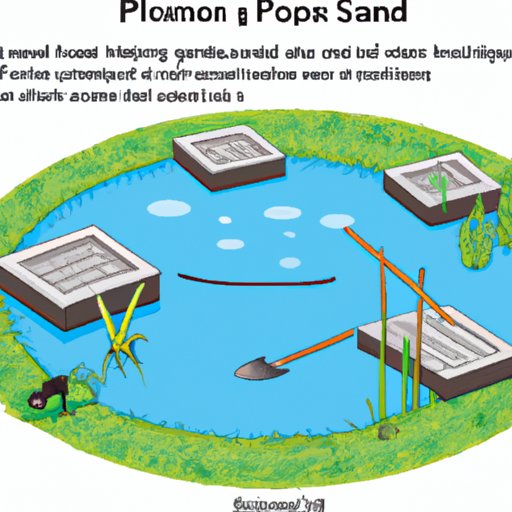
I. Introduction
Are you looking to add a touch of tranquility to your outdoor space? Building a pond might be just what you need. Not only will a pond enhance the beauty of your yard, but it can also improve your mental health by providing a space to relax and unwind. In this article, we’ll take a look at the seven simple steps you need to take to build the perfect pond, as well as provide tips and tricks for success, everything you need to know about building a backyard pond, and more.

II. 7 Simple Steps to Build Your Perfect Pond
Building a pond may seem like a daunting task, but it can be broken down into seven simple steps.
Step 1: Determine Size and Location
Before you start building your pond, you need to determine the size and location. Consider the amount of sunlight the area receives, whether it’s in a shady area or a sunny spot. Make sure to choose a level area, otherwise your pond may become unbalanced and leak. Once you’ve settled on a spot, mark out the area where the pond will be.
Step 2: Develop a Design and Plan
Once you’ve determined the size and location, you need to come up with a design and plan. Decide what style of pond you want, including the shape and depth. From there, you can determine what materials and tools you will need to bring your design to life.
Step 3: Excavate the Pond Area
The next step is to excavate the pond area. This process involves digging out the marked area of the pond, creating the desired size and shape. It’s important to create a sloping inner shelf around the perimeter of the pond to help plants and animals move easily in and out of the water.
Step 4: Install the Pond Liner
After excavating the pond area, you will need to install the pond liner. A pond liner prevents water from seeping into the surrounding soil. You will also need to install any necessary filtration and plumbing systems at this point.
Step 5: Add the Water Feature
Your pond will be incomplete without a water feature. You can choose a fountain or a waterfall, depending on the size and style of your pond. Your chosen water feature needs to have a strong pump to ensure it operates effectively.
Step 6: Add Plants and Fish
To make your pond look and feel like a natural ecosystem, it’s important to add plants and fish. Plants optimize the health of your pond by reducing algae buildup, and fish create a dynamic and natural ecosystem. Be sure to select plants and fish that are suitable for the size and location of your pond.
Step 7: Maintenance and Cleaning
A pond requires regular maintenance and cleaning, which involves testing water quality and monitoring plant and fish health. Additionally, you need to keep up with the cleaning of the pond liner, pumps, and filters to prevent damage and ensure longevity.
III. The Beginner’s Guide to Building a Backyard Pond
A. Overview of the basics of pond building
If you’re completely new to pond building, start here. This section will provide an overview of what you need to think about before you get started.
B. Materials needed for building a backyard pond
Make sure you have the right materials before starting your project. Common materials include a pond liner, filter system and pump, and aquatic plants.
C. Step-by-step guide for building a pond from scratch
This step-by-step guide will take you through the pond building process in detail, from marking out the space and excavating to adding decorations and plants.
IV. DIY Pond Building: Tips and Tricks for Success
A. Key tips to ensure pond building success
Here we take a look at some of the most important tips to keep in mind when building a pond, including determining size and location, selecting materials, and preparing the site.
B. How to troubleshoot common pond building problems
Even with careful planning and preparation, issues can arise when building a pond. In this section, we’ll take a look at some of the most common problems, such as leaks or uneven water levels, and how to solve them.
C. Suggestions for preventing problems before they occur
Prevention is key to avoiding problems when you’re constructing a pond. Here we’ll discuss some easy ways to reduce the likelihood of issues arising before construction starts and during pond maintenance.
V. Creating a Beautiful Oasis: Building a Water Feature in Your Yard
A. Why water features are important for outdoor spaces
Water features add interest, texture, and sound to your backyard. They not only serve as visually appealing landscape features but can also provide psychological benefits, such as stress-relief and encouraging relaxation.
B. Types of water features
There’s no shortage of options when it comes to water features; from bird baths to small fountains and even large ponds, the possibilities are endless. In this section, we’ll take a look at some of the most common types of water features you can add to your yard.
C. How to design and install a water feature as part of a larger outdoor space
Adding a water feature goes hand-in-hand with outdoor landscaping. In this section, we’ll cover how to incorporate a water feature as part of a larger outdoor space’s design, tying in elements like hardscaping, plants, and outdoor lighting.
VI. From Planning to Maintenance: All You Need to Know About Building a Pond
This section provides a comprehensive overview of the pond building process, from planning and preparing the site to maintenance and cleaning.
A. Planning your pond: determining size, location, and design
Before starting the construction process, it’s essential to determine key factors such as size and design. Planning your pond down to the smallest detail ensures you will enjoy it for years to come.
B. Excavating and installing a pond liner
The actual excavation and liner installation processes involve a lot of work, but are absolutely necessary to ensure the longevity and effectiveness of your pond. This section will go over everything you need to keep in mind during these crucial steps.
C. Adding a water feature
The water feature you choose will be a significant aspect of your pond. Adding a fountain or waterfall will make your pond feel even more natural and create a dynamic environment for your plants and fish to thrive.
D. Adding plants and fish
Adding plants and fish is perhaps the most fun component of pond construction. However, it takes careful consideration to ensure that fish and plants thrive in this new habitat. We’ll cover everything you need to know to select the right ones for your pond and give them the best environment possible.
E. Maintaining and cleaning your pond
Regular maintenance of your pond is crucial to prevent issues such as algae overgrowth or water contamination. In this section, we’ll discuss cleaning techniques, how to manage plant growth, and other essential maintenance practices.
VII. Building a Pond: A Weekend DIY Project
A. How to build a pond over a weekend
If you want to build a pond quickly, this section will offer some weekend-project-sized help.
B. Materials and tools needed for a weekend project
Besides a few key building materials and tools, you probably have many of the items needed to construct a small pond already. In this section, we’ll provide a list of the basics you’ll need to get started.
C. Step-by-step guide for building a pond in a weekend
For those who want to conquer a pond-building project quickly, this step-by-step guide will get you through the process in a speedy amount of time while ensuring success.
VIII. Transforming Your Outdoor Space: Build a Pond in 5 Easy Steps
A. Overview of the 5 steps
Creating a stunning pond in your yard is possible in just five simple steps. This section will provide an overview of the process.
B. Step 1: Choose the perfect location
Determining the right site for your pond is the first step. We’ll go over how to find the best spot for your new pond in this section.
C. Step 2: Determine the size
Once you’ve chosen a location, you need to determine the size of your pond. We’ll cover how to select the ideal size based on your specific preferences and needs.
D. Step 3: Excavate the pond area
After you’ve chosen the site and size, you need to prepare the area for excavation. This section will provide pointers on how to construct the physical shallow area for plants to thrive and how to dig the pond area.
E. Step 4: Install the pond liner
The pond liner keeps the water contained within the boundaries of the pond area. Here you’ll learn about the various materials used for pond liners and how to lay and shape them to the shape, size, and depth of your pond.
F. Step 5: Add water, plants, and fish
Your pond wouldn’t be complete without plants and fish. We’ll cover how to add the finishing touches and create a healthy aquatic environment for your new pets.
IX. Conclusion
Now that you know everything you need to about building a pond, it’s time to get started! Building a pond is a great way to create a relaxing and beautiful outdoor space that you can enjoy for years to come. With careful planning and regular maintenance, you’ll be well on your way to creating your personalized pond oasis. For more in-depth information, check out books or searchable online resources on pond construction.




